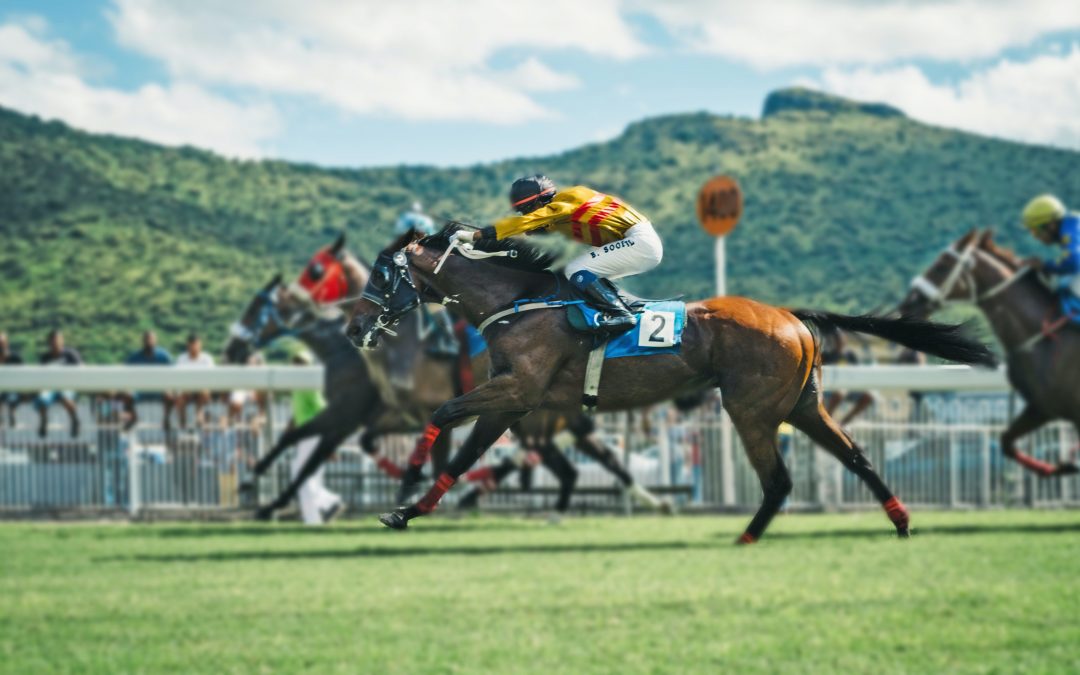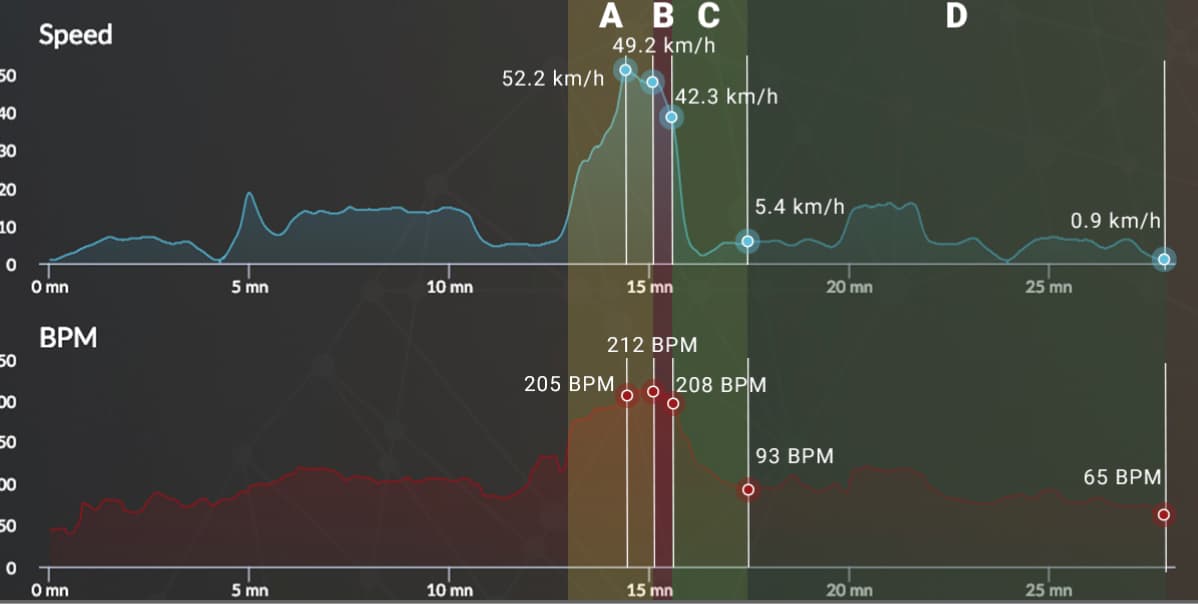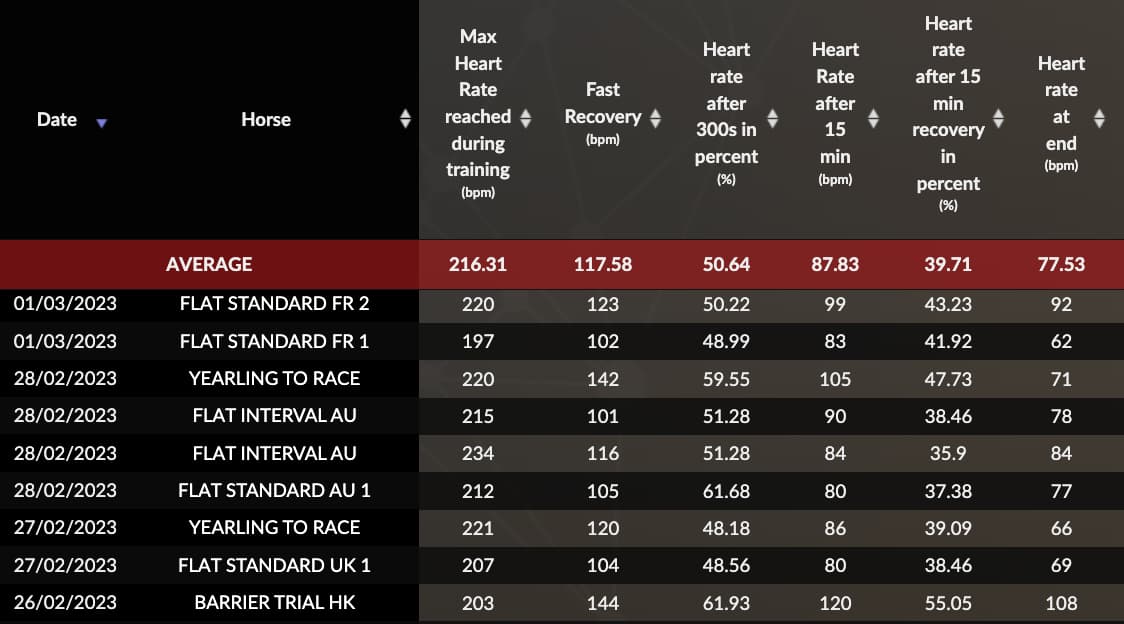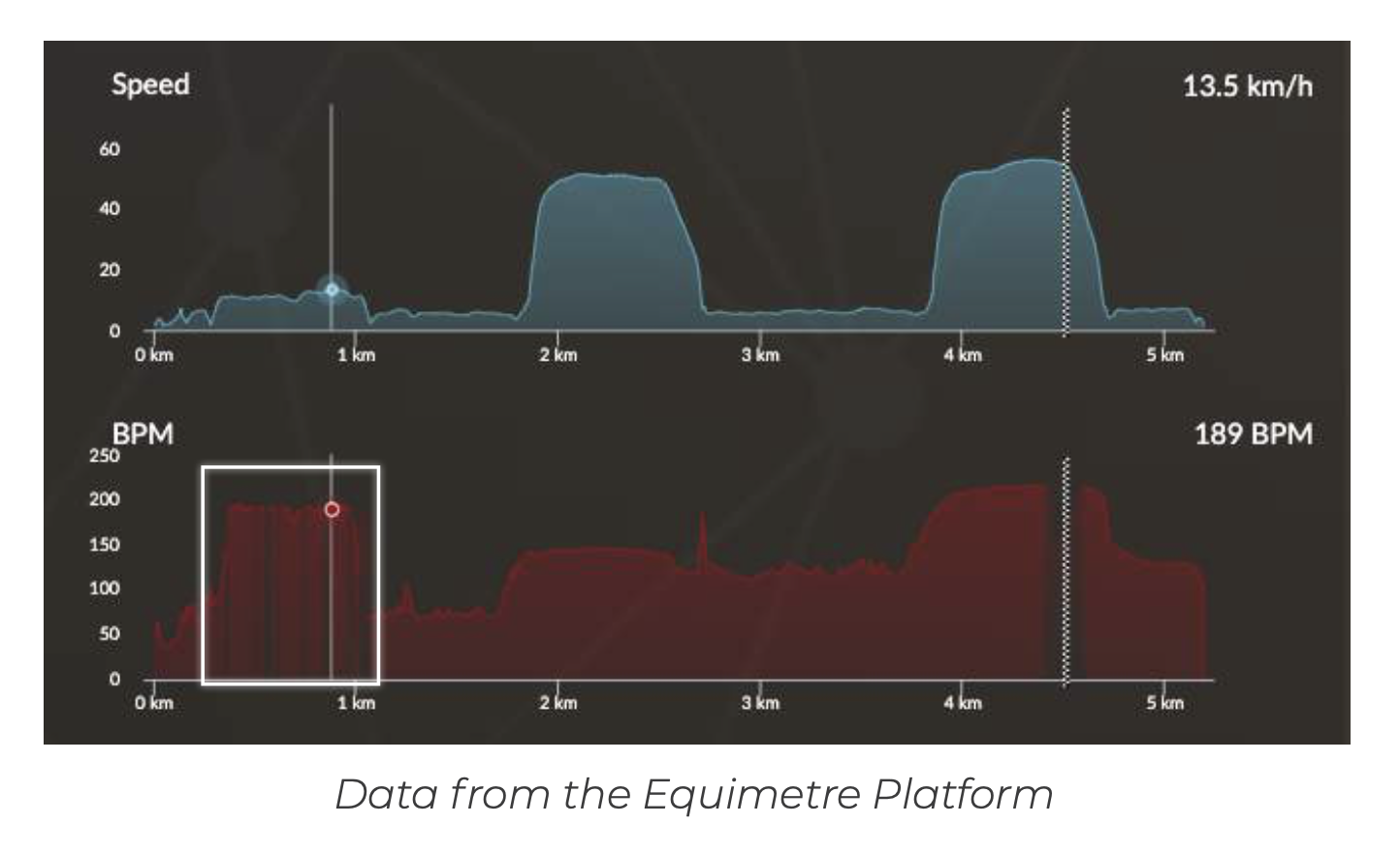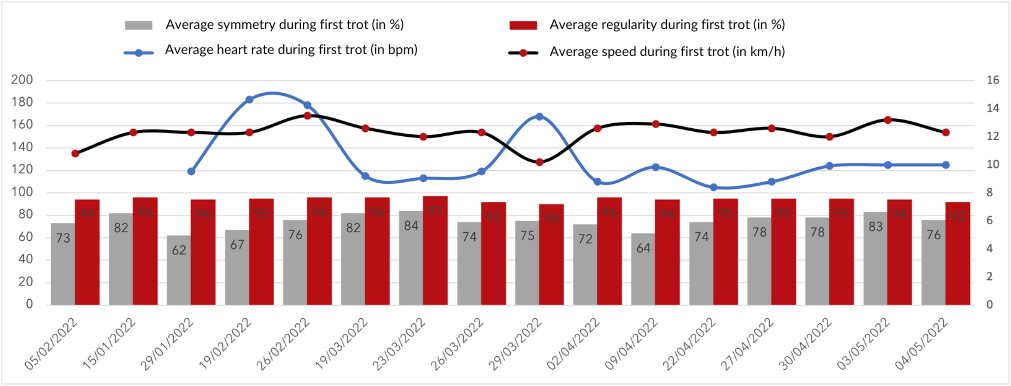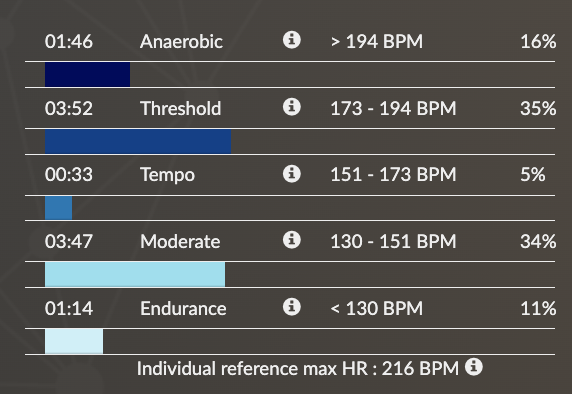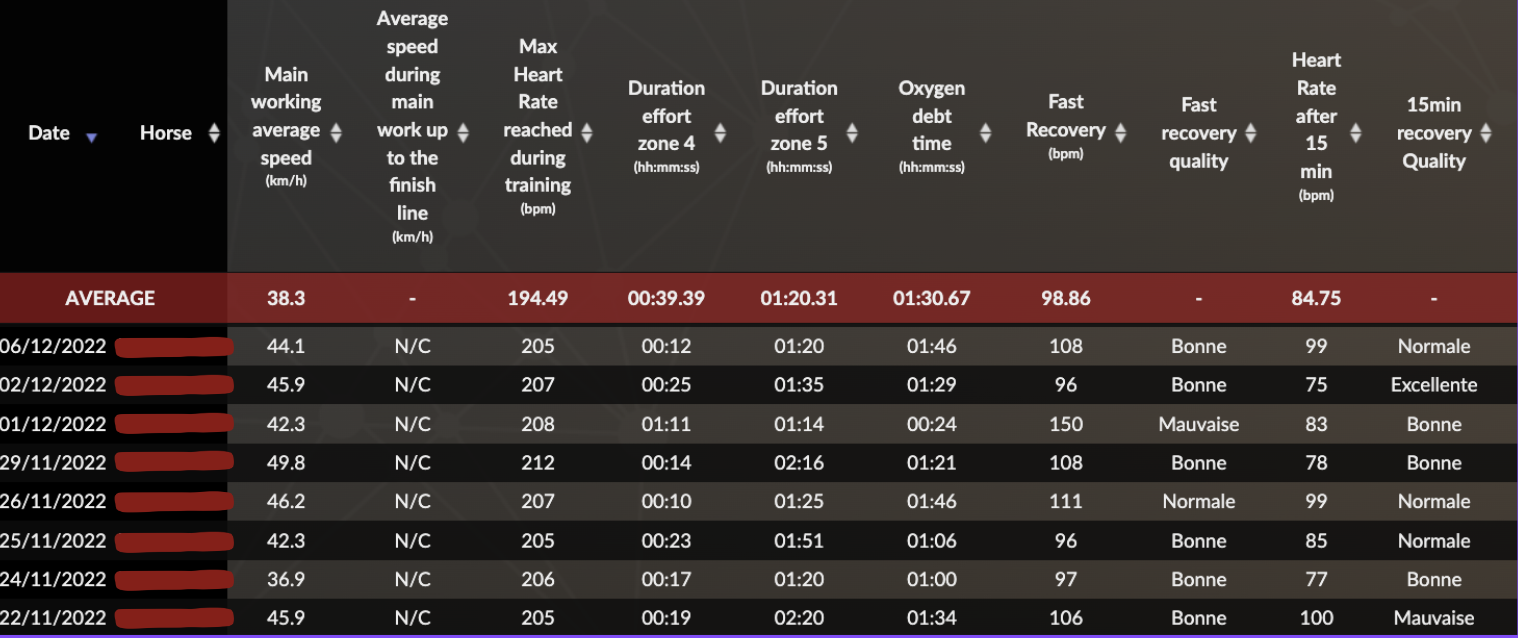A racehorse heart rate monitor is an important tool when it comes to sports training, as it allows you to record your heart rate down to the second. Discover these 6 keys to analysing a racehorse’s heart rate, to get the most out of a tool like Equimetre.
On the agenda:
Basic principles of the racehorse’s heart rate
Why measure heart rate in racehorses?
Analyse the maximum heart rate to evaluate the intensity of the effort
Four heart rate zones to evaluate the racehorse’s fitness
Analyse your racehorse’s recovery in percentage of their HRmax
Heart rate during warm-up to detecte pathologies
Speed at 200 beats per minute, or V200 to compare horses
Measure the time spent in Zone 4 & 5
Basic principles of the racehorse’s heart rate
The heart rate is the number of contractions initiated by the heart over a given period of time. It is usually measured in beats per minute (or BPM), and is essential in assessing the fitness of a racehorse.
At rest, a horse’s heart rate range from 25 to 40 BPM on average. However, it can vary up to more than 100 BPM under the influence of excitement, fear, or any other event. For example, the mere presence of a person in the stall or around a horse can also increase the resting heart rate. A low resting heart rate indicates good physical condition and relaxation, while a high resting heart rate is usually associated with overtraining, illness or poor physical condition.
During a physical effort or training, the horse’s heart rate increases significantly. Indeed, the heart rate evolves linearly with the effort intensity. In general, the maximum heart rate of a horse, i.e. the heart rate that a horse cannot exceed, is around 218 BPM.
Why measure heart rate in racehorses?
Heart rate analysis has many virtues in the life of a racehorse. In an increasingly competitive sector, its analysis is an undeniable competitive advantage. Moreover, the frequent analysis of your horse’s ECG is a precious asset for his health and well-being.
From a performance point of view, the collection of cardiac data improves the quality of the follow-up of your race horses. For example, you can measure the evolution of a horse by comparing its V200 at several moments of the season and its career. Tracking heart rate also allows you to evaluate the fitness of a horse, thanks to the evaluation of his recovery. Finally, by analyzing the percentage of max HR at which your horses worked, you can deduce the intensity of the exercise performed.
Regarding your horses’ health, the ECG plays an equally important role. It allows you to prevent and detect possible pathologies or pain. A heart rate higher than usual usually highlights unwanted stress or pain suffered by your horse. It can also indicate overtraining, which can have a negative impact on his performance and career.
You now have all the keys in hand to analyze the heart rate collected, during exercise or at rest, by EQUIMETRE!
1. Analyse the maximum heart rate to evaluate the intensity of the effort
The maximum heart rate of a horse (or max HR) measures the maximum number of beats per minute that a horse can reach during its effort. When a horse reaches its maximum heart rate, it gallops at a speed that it can only sustain for 600 to 800 meters. This max HR varies depending on the horse and its predispositions. On average, it is between 204 and 241 BPM (Evans, 2007).
Evaluating a horse’s heart rate allows to personalize its training and to make him work at percentages of his max HR adapted to its capacities. For example, training at 70% of a horse’s heart rate would be an active recovery, which can be effective in improving blood flow and aerobic fitness as well as stamina.
It is important to know that the maximum heart rate does not vary according to the volume or quality of a horse’s training. In the long term, it decreases slightly with age. However, the speed reached at maximum heart rate can vary according to the training. If it increases, it is a good sign and indicates a good state of fitness: the horse is able to gallop faster for the same heart rate.
It is important to remember that the max HR is closely linked to the efficiency of the heart. A strong heart does not need to beat as fast to expel the same amount of oxygen as a weaker heart. A blood system that is better supplied with oxygen by the heart has a higher resistance to effort.
2. Four heart rate zones to analyse to evaluate the physical condition of a race horse
The heart rate depends on the activity of the horse. Thus, the heart rate of a horse during a work is totally different from that at rest. It can therefore be analyzed by dividing the exercise into different intensity zones:
1/ The working zone: heart rate and speed are high. The horse is actively working and improving its aerobic and anaerobic qualities.
2/ The deceleration zone at the end of the work: the speed decreases drastically, but the heart rate remains high. This zone marks the end of the intense training and the beginning of the “return to calm”, it is fundamental in improving the horse’s performance.
3/ The zone of rapid decrease of the heart rate: the speed remains low, and the heart rate slows down strongly. It can last more or less time depending on the horse. The shorter the rapid decay zone, the greater the horse’s ability to recover quickly.
4/ The slow heart rate decay zone: the speed is minimal (walk or slow trot) and the heart rate decrease gradually slows down. This is the slow recovery zone, at which point the effort is usually over since about 15 minutes. The fittest horses will have fallen back to a low heart rate, close to their average resting heart rate.
3. Analyse your racehorses’ recovery in percentage of their HRmax
We can evaluate the horse’s performance based on this information. If this number is close to the average, the horse handled the workload rather well. On the other hand, if this figure is very high, it means that your horse had difficulty performing the necessary exercise.
The fast recovery in percentage of HRmax is the percentage of fast recovery heart rate. This percentage enables us to compare horses regardless of their HRmax level. For example, if a horse’s heart rate is 217 BPM and his heart rate soon after exercise is 118 BPM, his recovery after exercise will be (118 / 217) x 100 = 54%.
On average, this figure is roughly 55%.
For example, if we were to look only at the fast recovery in BPM, we would think that Flat Standard FR 2 has a much worse recovery compared to Flat Standard FR 1. But when we compare their percentages in HRmax after 300s, we can see that they’re both really close, with respectively 50% and 48%. This is why this parameter is very important and is the best way to compare your racehorses’ recovery.
4. Heart rate during warm-up to detect pathologies
By gathering all the heart rate data of your horses, Equimetre Analytics Premium (EAP) allows to distinguish an average data range for each horse. Hence, it is possible to detect any abnormal value and to identify unwanted variations before, during or after training. This enhances prevention work and minimizes drastically the risk of injury. The main parameters to be monitored are: heart rate during the first gallop and trot (an abnormal increase is generally due to pain), recovery, speed and locomotion data (regularity, stride length, symmetry).
An elevated heart rate during warm-up can be a sign of pain. The horse may be in discomfort somewhere, and this is expressed by an increased heart rate even though the effort intensity is not high.
For example, on the 19th and 26th of February, we observed an unusual average heart rate during the warm-up. The horse was having seam, which was causing discomfort, as we can see from the average symmetry, and the average heart rate of this period.
5. Speed at 200 beats per minute, or V200 to compare horses
V200 measures the speed a horse reaches when its heart is beating at a rate of 200 beats per minute. V200 is a useful parameter for comparing horses in a stable. A horse with a higher speed than another horse with the same heart rate is considered more physically fit. This characteristic can be worked on in training and can be compared over time in the same horse. Indeed, if a horse increases its V200, it is a sign of effective training.
6. Measure the time spent in Zone 4 & 5
The amount of time spent in each heart rate (HR) zone can be measured for each training session. These heart rate zones are determined by each horse’s maximal heart rate (max HR). As a result, they are not the same for all horses and refer to intensity levels in relation to the horse’s maximal intensity level, which is reached when the horse’s heart rate is at its highest.
The effort zone to be reached is mostly influenced by the training goals. Zone 5 is the most intensive effort zone.
This is a great tool to assess the intensity of a training, but also to view the progress of a horse. For example, a horse that has improved will spend less time in Zone 5, for the same level of intensity.
It is a good indicator to assess the training intensity, but to also understand a poor recovery when you start to compare trainings. It will provide you more insights into how did the horse cope with a particular exercise.
As an example, if we compare the training sessions from the 2nd and the 6th of December, it seems that the horse had greater difficulty recovering from the latter, even if the working pace was lower. But, as we can see, the horse spent more time in zone 5 than any other, making the training more difficult for him.
Keywords: racehorse heart rate, maximum heart rate analysis, heart rate zones for training, overtraining, undertraining, V200 for racehorses, ECG analysis for horses

